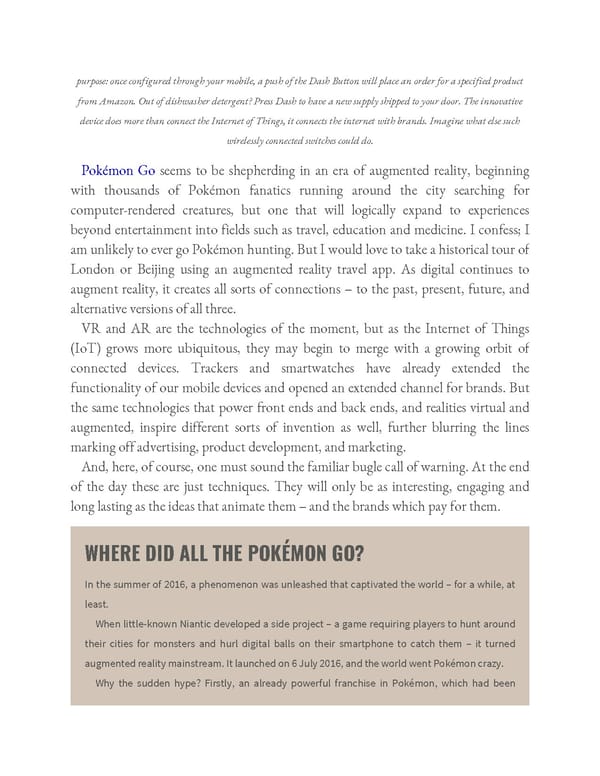purpose: once configured through your mobile, a push of the Dash Button will place an order for a specified product from Amazon. Out of dishwasher detergent? Press Dash to have a new supply shipped to your door. The innovative device does more than connect the Internet of Things, it connects the internet with brands. Imagine what else such wirelessly connected switches could do. Pokémon Go seems to be shepherding in an era of augmented reality, beginning with thousands of Pokémon fanatics running around the city searching for computer-rendered creatures, but one that will logically expand to experiences beyond entertainment into fields such as travel, education and medicine. I confess; I am unlikely to ever go Pokémon hunting. But I would love to take a historical tour of London or Beijing using an augmented reality travel app. As digital continues to augment reality, it creates all sorts of connections – to the past, present, future, and alternative versions of all three. VR and AR are the technologies of the moment, but as the Internet of Things (IoT) grows more ubiquitous, they may begin to merge with a growing orbit of connected devices. Trackers and smartwatches have already extended the functionality of our mobile devices and opened an extended channel for brands. But the same technologies that power front ends and back ends, and realities virtual and augmented, inspire different sorts of invention as well, further blurring the lines marking off advertising, product development, and marketing. And, here, of course, one must sound the familiar bugle call of warning. At the end of the day these are just techniques. They will only be as interesting, engaging and long lasting as the ideas that animate them – and the brands which pay for them. WHERE DID ALL THE POKÉMON GO? In the summer of 2016, a phenomenon was unleashed that captivated the world – for a while, at least. When little-known Niantic developed a side project – a game requiring players to hunt around their cities for monsters and hurl digital balls on their smartphone to catch them – it turned augmented reality mainstream. It launched on 6 July 2016, and the world went Pokémon crazy. Why the sudden hype? Firstly, an already powerful franchise in Pokémon, which had been
 Ogilvy on Advertising in the Digital Age Page 276 Page 278
Ogilvy on Advertising in the Digital Age Page 276 Page 278